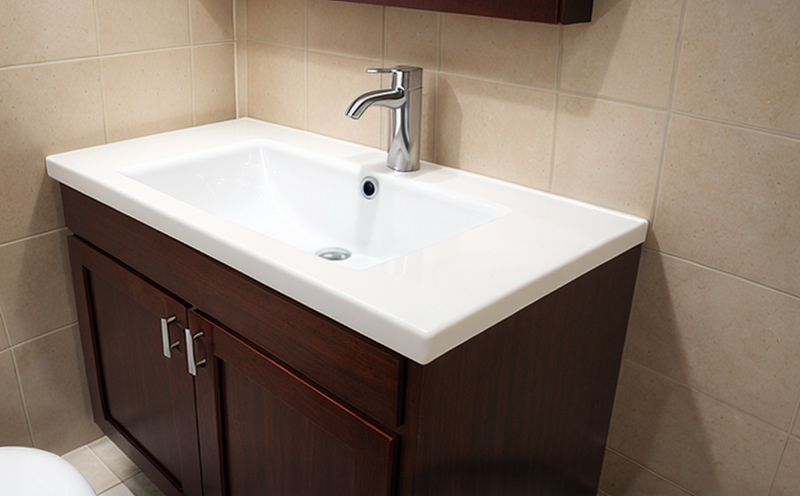ISO 175 Chemical Resistance Testing of Bathroom Plastics
ISO 175 chemical resistance testing is a critical procedure in the evaluation of plastics used in bathroom fixtures and sanitary products. This test assesses the durability and integrity of materials under exposure to various chemicals, simulating real-world conditions they might encounter during use or storage. For instance, certain bathroom plastics may be exposed to cleaning agents, detergents, and other chemical substances that can cause degradation over time. The ISO 175 method ensures that these plastics maintain their physical properties and structural integrity. The testing process involves submerging the specimens in a solution containing the targeted chemicals for specified durations at controlled temperatures. After exposure, the samples are evaluated using various techniques to measure changes in dimensions, weight, color, and mechanical properties such as tensile strength, flexural modulus, and impact resistance. This standardized approach is crucial for ensuring that bathroom plastics meet regulatory requirements and perform reliably under expected environmental conditions. The importance of this test cannot be overstated, especially given the increasing demand for sustainable and environmentally friendly products in the bathroom fixtures market. Manufacturers must ensure their materials can withstand harsh chemical environments without compromising safety or performance. Compliance with international standards like ISO 175 is essential to gain competitive advantage and build consumer trust. In addition to its role in quality assurance, ISO 175 testing helps identify potential issues early in the product development cycle, enabling manufacturers to make necessary adjustments before mass production begins. By incorporating this test into their R&D processes, companies can enhance product longevity and reliability, which are key factors influencing customer satisfaction and brand reputation.Benefits
- Evaluates the durability of bathroom plastics against chemical exposure.
- Ensures compliance with international standards like ISO 175.
- Identifies potential issues in product development early on.
- Enhances product longevity and reliability.
- Builds consumer trust by demonstrating high-quality materials.
- Aids in regulatory compliance, reducing the risk of non-conformance penalties.
- Promotes sustainable practices through the use of tested, durable plastics.
Quality and Reliability Assurance
Quality assurance (QA) in ISO 175 chemical resistance testing is paramount for maintaining consistent product quality. QA processes ensure that each step from sample preparation to final analysis adheres strictly to the requirements set by ISO standards. This includes precise measurement of specimen dimensions, accurate weighing before and after exposure, and meticulous recording of all test parameters. At our laboratory, we employ state-of-the-art equipment and highly trained technicians to carry out these tests with utmost precision. Our QA protocols emphasize repeatability and reproducibility, ensuring that results are consistent across multiple batches or samples. This rigorous approach guarantees reliable data that can be used confidently in decision-making processes related to product design and manufacturing. In addition to technical accuracy, our QA framework includes regular calibration of instruments and periodic audits by independent third parties. These measures further enhance the credibility of our test results, providing clients with peace of mind regarding the quality and reliability of their products.Competitive Advantage and Market Impact
Achieving ISO 175 chemical resistance testing not only meets regulatory requirements but also significantly enhances a company’s competitive edge in the bathroom fixtures market. In an increasingly globalized industry, adherence to international standards demonstrates commitment to excellence and sets a benchmark for quality. From a business perspective, successful completion of this test can lead to several advantages:- Increased market penetration by establishing trust with customers.
- Potential cost savings through reduced warranty claims and recalls.
- Increased sales due to improved product performance and reliability.
- Enhanced brand reputation, attracting more discerning consumers.
Frequently Asked Questions
What is the purpose of ISO 175 chemical resistance testing?
The primary purpose of ISO 175 testing is to evaluate how well plastics withstand exposure to chemicals, ensuring they maintain their integrity and performance over time.
Which chemicals are typically tested in ISO 175?
Commonly tested chemicals include household cleaners, detergents, and other substances that bathroom plastics may encounter during use.
How long does the testing process usually take?
The duration varies depending on the specific chemicals used but typically ranges from several days to a few weeks.
Is this test mandatory for all bathroom plastics?
While not always legally required, ISO 175 testing is highly recommended as it ensures the highest quality and reliability of materials.
What kind of equipment is used during this test?
Advanced apparatus such as autoclaves, incubators, and precise measurement tools are utilized to ensure accurate testing results.
How does ISO 175 impact product design?
It allows designers to select materials that not only meet performance expectations but also withstand the rigors of real-world chemical exposure.
What are the consequences of failing this test?
Failing ISO 175 testing can lead to product recalls, damage to brand reputation, and potential legal issues. It also hampers market entry into compliance-sensitive regions.
How does this test contribute to sustainability?
By ensuring materials are durable and reliable, ISO 175 testing supports the development of sustainable products that last longer without compromising performance.





